Environmental Pollution: A Report on POPs Control in China and USA
VerifiedAdded on 2023/06/05
|9
|1759
|278
Report
AI Summary
This report provides a comparative analysis of the control and regulation of Persistent Organic Pollutants (POPs) in China and the United States. China, as a signatory to the Stockholm Convention, has implemented various measures to reduce and eliminate POPs emissions, including establishing the China National Coordination Group and releasing a national implementation plan. These efforts have led to positive effects in reducing ecosystem and human exposure to POPs. While the United States has not ratified the Stockholm Convention, it was an early leader in managing POPs, with the EPA taking regulatory action against DDT in 1969 and implementing various domestic laws. The report highlights key environmental standards, laws, and regulations in both countries, along with performance indicators for POPs control, emphasizing the importance of global treaties like the Stockholm Convention in protecting the environment and human health from POPs.
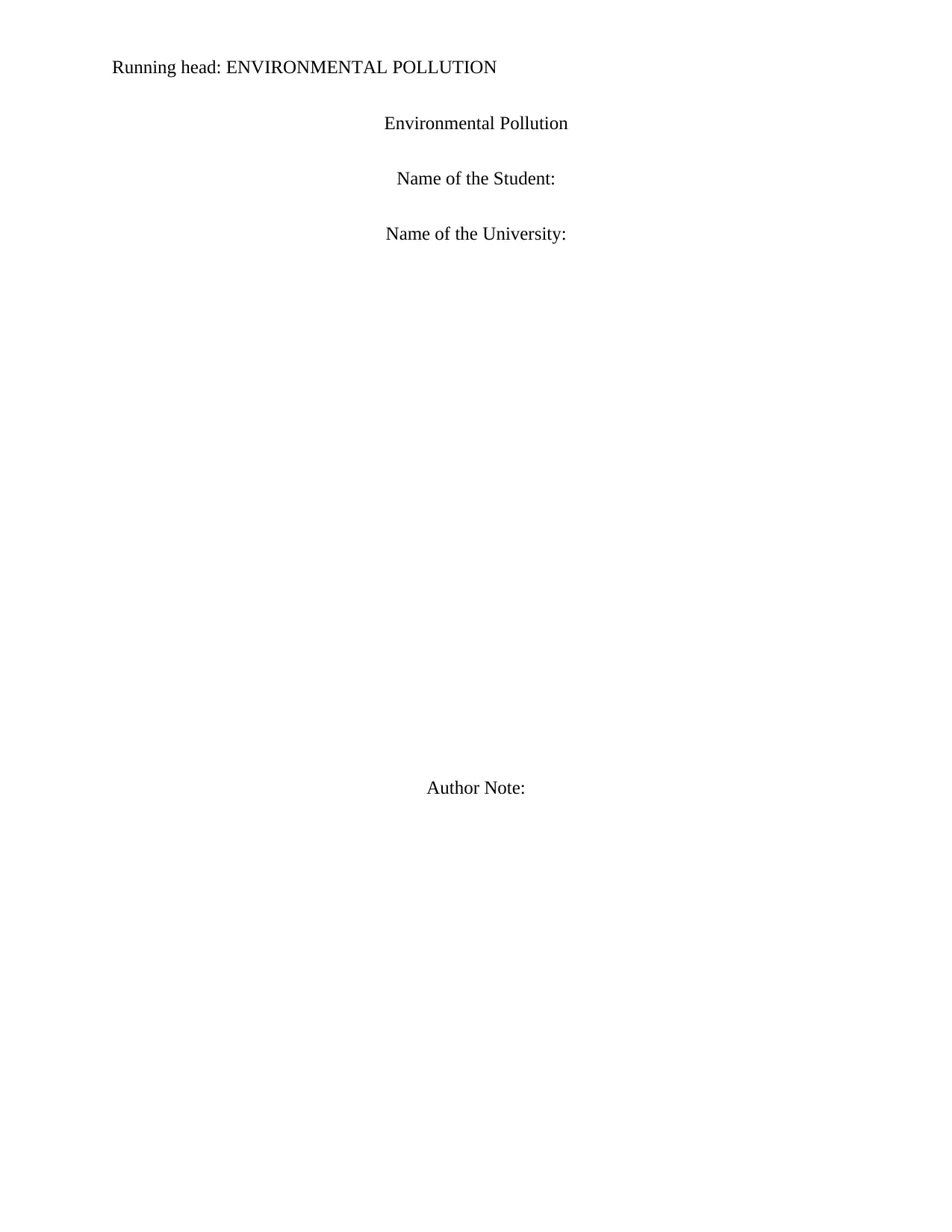
Running head: ENVIRONMENTAL POLLUTION
Environmental Pollution
Name of the Student:
Name of the University:
Author Note:
Environmental Pollution
Name of the Student:
Name of the University:
Author Note:
Paraphrase This Document
Need a fresh take? Get an instant paraphrase of this document with our AI Paraphraser
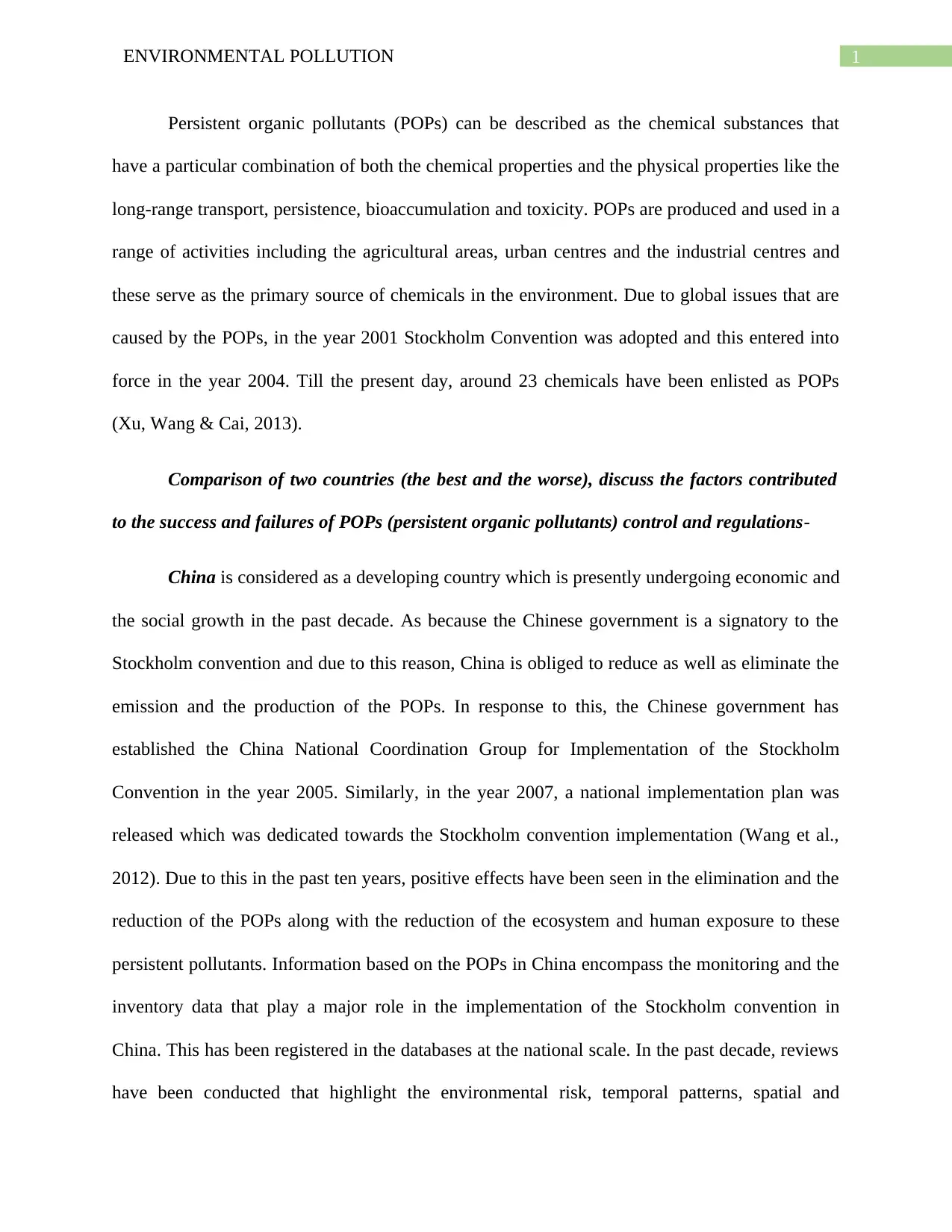
1ENVIRONMENTAL POLLUTION
Persistent organic pollutants (POPs) can be described as the chemical substances that
have a particular combination of both the chemical properties and the physical properties like the
long-range transport, persistence, bioaccumulation and toxicity. POPs are produced and used in a
range of activities including the agricultural areas, urban centres and the industrial centres and
these serve as the primary source of chemicals in the environment. Due to global issues that are
caused by the POPs, in the year 2001 Stockholm Convention was adopted and this entered into
force in the year 2004. Till the present day, around 23 chemicals have been enlisted as POPs
(Xu, Wang & Cai, 2013).
Comparison of two countries (the best and the worse), discuss the factors contributed
to the success and failures of POPs (persistent organic pollutants) control and regulations-
China is considered as a developing country which is presently undergoing economic and
the social growth in the past decade. As because the Chinese government is a signatory to the
Stockholm convention and due to this reason, China is obliged to reduce as well as eliminate the
emission and the production of the POPs. In response to this, the Chinese government has
established the China National Coordination Group for Implementation of the Stockholm
Convention in the year 2005. Similarly, in the year 2007, a national implementation plan was
released which was dedicated towards the Stockholm convention implementation (Wang et al.,
2012). Due to this in the past ten years, positive effects have been seen in the elimination and the
reduction of the POPs along with the reduction of the ecosystem and human exposure to these
persistent pollutants. Information based on the POPs in China encompass the monitoring and the
inventory data that play a major role in the implementation of the Stockholm convention in
China. This has been registered in the databases at the national scale. In the past decade, reviews
have been conducted that highlight the environmental risk, temporal patterns, spatial and
Persistent organic pollutants (POPs) can be described as the chemical substances that
have a particular combination of both the chemical properties and the physical properties like the
long-range transport, persistence, bioaccumulation and toxicity. POPs are produced and used in a
range of activities including the agricultural areas, urban centres and the industrial centres and
these serve as the primary source of chemicals in the environment. Due to global issues that are
caused by the POPs, in the year 2001 Stockholm Convention was adopted and this entered into
force in the year 2004. Till the present day, around 23 chemicals have been enlisted as POPs
(Xu, Wang & Cai, 2013).
Comparison of two countries (the best and the worse), discuss the factors contributed
to the success and failures of POPs (persistent organic pollutants) control and regulations-
China is considered as a developing country which is presently undergoing economic and
the social growth in the past decade. As because the Chinese government is a signatory to the
Stockholm convention and due to this reason, China is obliged to reduce as well as eliminate the
emission and the production of the POPs. In response to this, the Chinese government has
established the China National Coordination Group for Implementation of the Stockholm
Convention in the year 2005. Similarly, in the year 2007, a national implementation plan was
released which was dedicated towards the Stockholm convention implementation (Wang et al.,
2012). Due to this in the past ten years, positive effects have been seen in the elimination and the
reduction of the POPs along with the reduction of the ecosystem and human exposure to these
persistent pollutants. Information based on the POPs in China encompass the monitoring and the
inventory data that play a major role in the implementation of the Stockholm convention in
China. This has been registered in the databases at the national scale. In the past decade, reviews
have been conducted that highlight the environmental risk, temporal patterns, spatial and
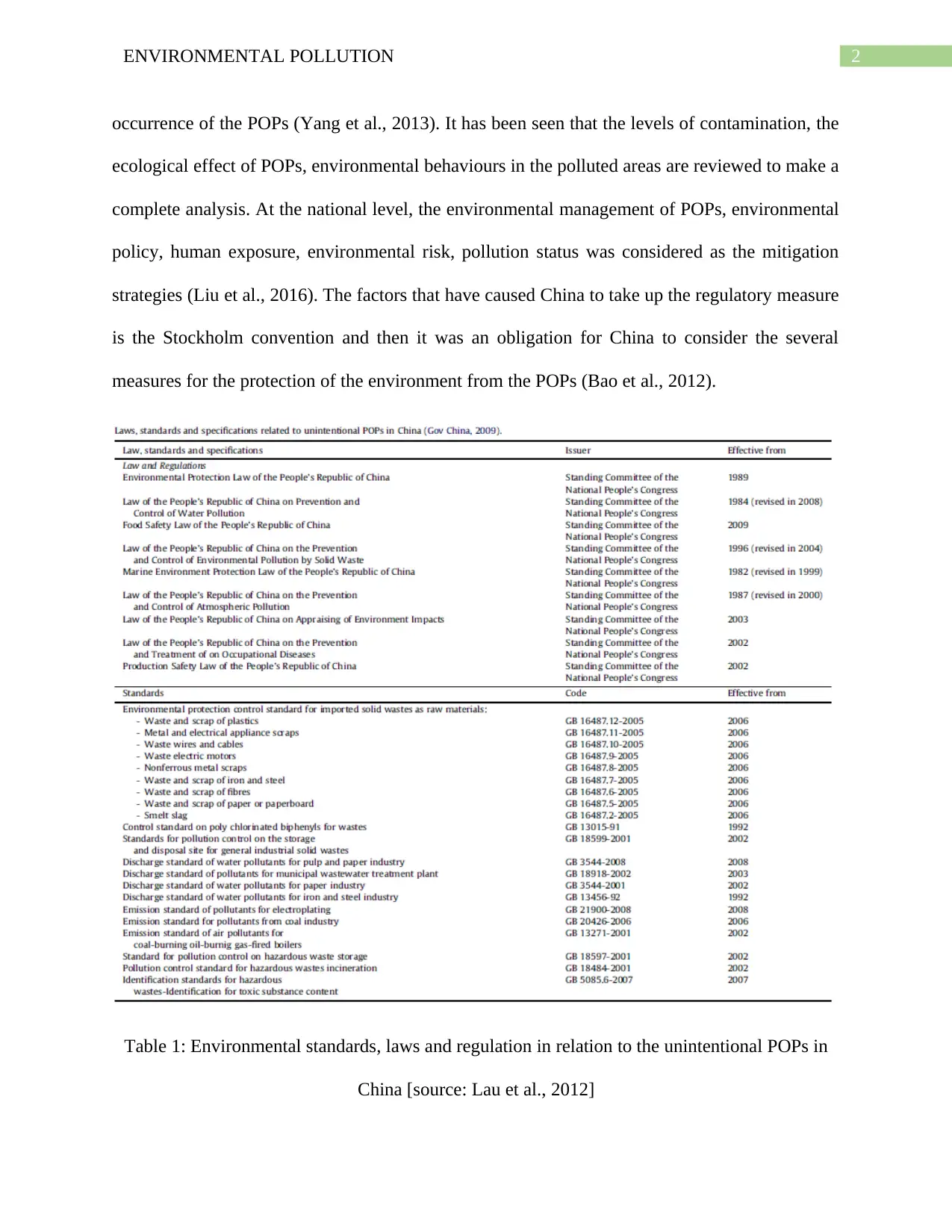
2ENVIRONMENTAL POLLUTION
occurrence of the POPs (Yang et al., 2013). It has been seen that the levels of contamination, the
ecological effect of POPs, environmental behaviours in the polluted areas are reviewed to make a
complete analysis. At the national level, the environmental management of POPs, environmental
policy, human exposure, environmental risk, pollution status was considered as the mitigation
strategies (Liu et al., 2016). The factors that have caused China to take up the regulatory measure
is the Stockholm convention and then it was an obligation for China to consider the several
measures for the protection of the environment from the POPs (Bao et al., 2012).
Table 1: Environmental standards, laws and regulation in relation to the unintentional POPs in
China [source: Lau et al., 2012]
occurrence of the POPs (Yang et al., 2013). It has been seen that the levels of contamination, the
ecological effect of POPs, environmental behaviours in the polluted areas are reviewed to make a
complete analysis. At the national level, the environmental management of POPs, environmental
policy, human exposure, environmental risk, pollution status was considered as the mitigation
strategies (Liu et al., 2016). The factors that have caused China to take up the regulatory measure
is the Stockholm convention and then it was an obligation for China to consider the several
measures for the protection of the environment from the POPs (Bao et al., 2012).
Table 1: Environmental standards, laws and regulation in relation to the unintentional POPs in
China [source: Lau et al., 2012]
⊘ This is a preview!⊘
Do you want full access?
Subscribe today to unlock all pages.

Trusted by 1+ million students worldwide
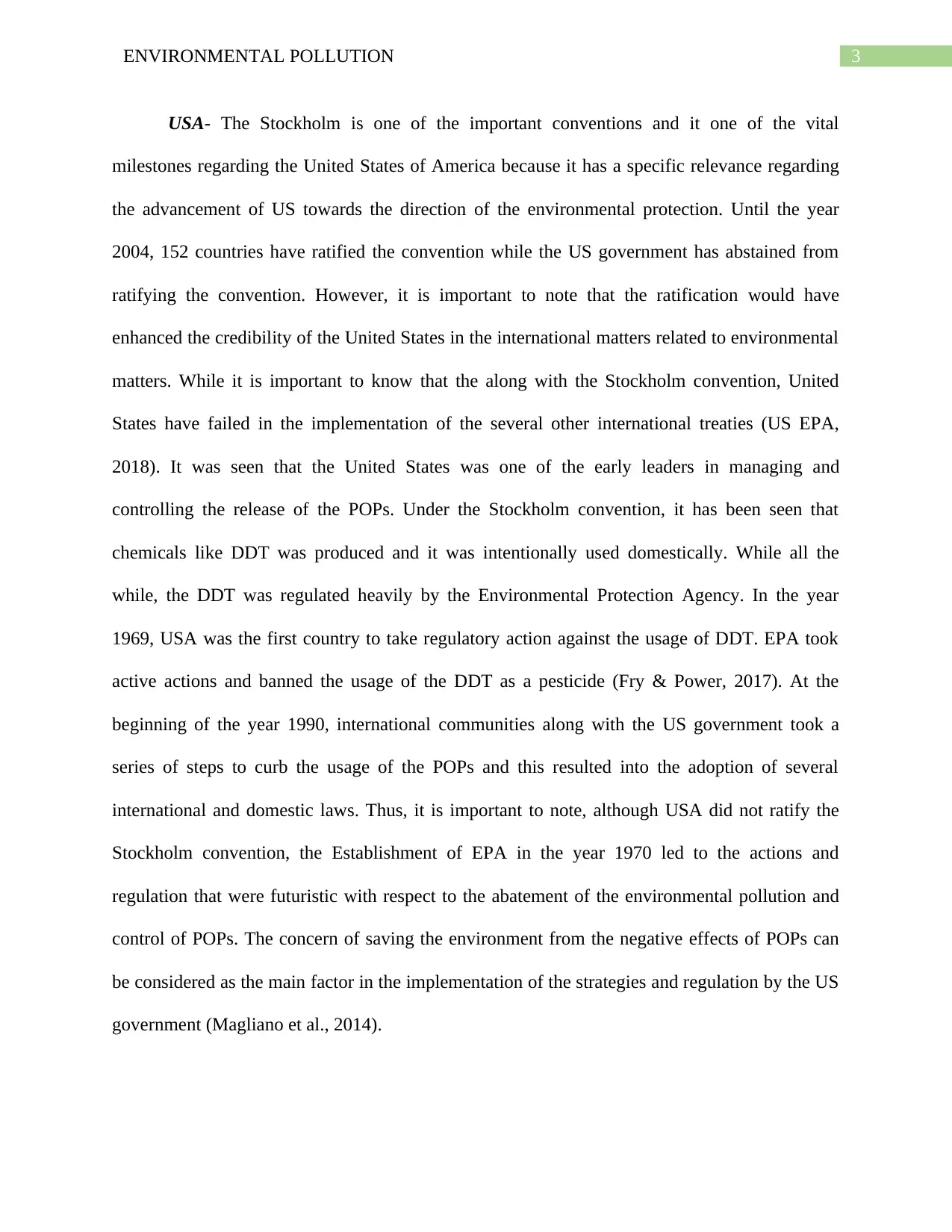
3ENVIRONMENTAL POLLUTION
USA- The Stockholm is one of the important conventions and it one of the vital
milestones regarding the United States of America because it has a specific relevance regarding
the advancement of US towards the direction of the environmental protection. Until the year
2004, 152 countries have ratified the convention while the US government has abstained from
ratifying the convention. However, it is important to note that the ratification would have
enhanced the credibility of the United States in the international matters related to environmental
matters. While it is important to know that the along with the Stockholm convention, United
States have failed in the implementation of the several other international treaties (US EPA,
2018). It was seen that the United States was one of the early leaders in managing and
controlling the release of the POPs. Under the Stockholm convention, it has been seen that
chemicals like DDT was produced and it was intentionally used domestically. While all the
while, the DDT was regulated heavily by the Environmental Protection Agency. In the year
1969, USA was the first country to take regulatory action against the usage of DDT. EPA took
active actions and banned the usage of the DDT as a pesticide (Fry & Power, 2017). At the
beginning of the year 1990, international communities along with the US government took a
series of steps to curb the usage of the POPs and this resulted into the adoption of several
international and domestic laws. Thus, it is important to note, although USA did not ratify the
Stockholm convention, the Establishment of EPA in the year 1970 led to the actions and
regulation that were futuristic with respect to the abatement of the environmental pollution and
control of POPs. The concern of saving the environment from the negative effects of POPs can
be considered as the main factor in the implementation of the strategies and regulation by the US
government (Magliano et al., 2014).
USA- The Stockholm is one of the important conventions and it one of the vital
milestones regarding the United States of America because it has a specific relevance regarding
the advancement of US towards the direction of the environmental protection. Until the year
2004, 152 countries have ratified the convention while the US government has abstained from
ratifying the convention. However, it is important to note that the ratification would have
enhanced the credibility of the United States in the international matters related to environmental
matters. While it is important to know that the along with the Stockholm convention, United
States have failed in the implementation of the several other international treaties (US EPA,
2018). It was seen that the United States was one of the early leaders in managing and
controlling the release of the POPs. Under the Stockholm convention, it has been seen that
chemicals like DDT was produced and it was intentionally used domestically. While all the
while, the DDT was regulated heavily by the Environmental Protection Agency. In the year
1969, USA was the first country to take regulatory action against the usage of DDT. EPA took
active actions and banned the usage of the DDT as a pesticide (Fry & Power, 2017). At the
beginning of the year 1990, international communities along with the US government took a
series of steps to curb the usage of the POPs and this resulted into the adoption of several
international and domestic laws. Thus, it is important to note, although USA did not ratify the
Stockholm convention, the Establishment of EPA in the year 1970 led to the actions and
regulation that were futuristic with respect to the abatement of the environmental pollution and
control of POPs. The concern of saving the environment from the negative effects of POPs can
be considered as the main factor in the implementation of the strategies and regulation by the US
government (Magliano et al., 2014).
Paraphrase This Document
Need a fresh take? Get an instant paraphrase of this document with our AI Paraphraser
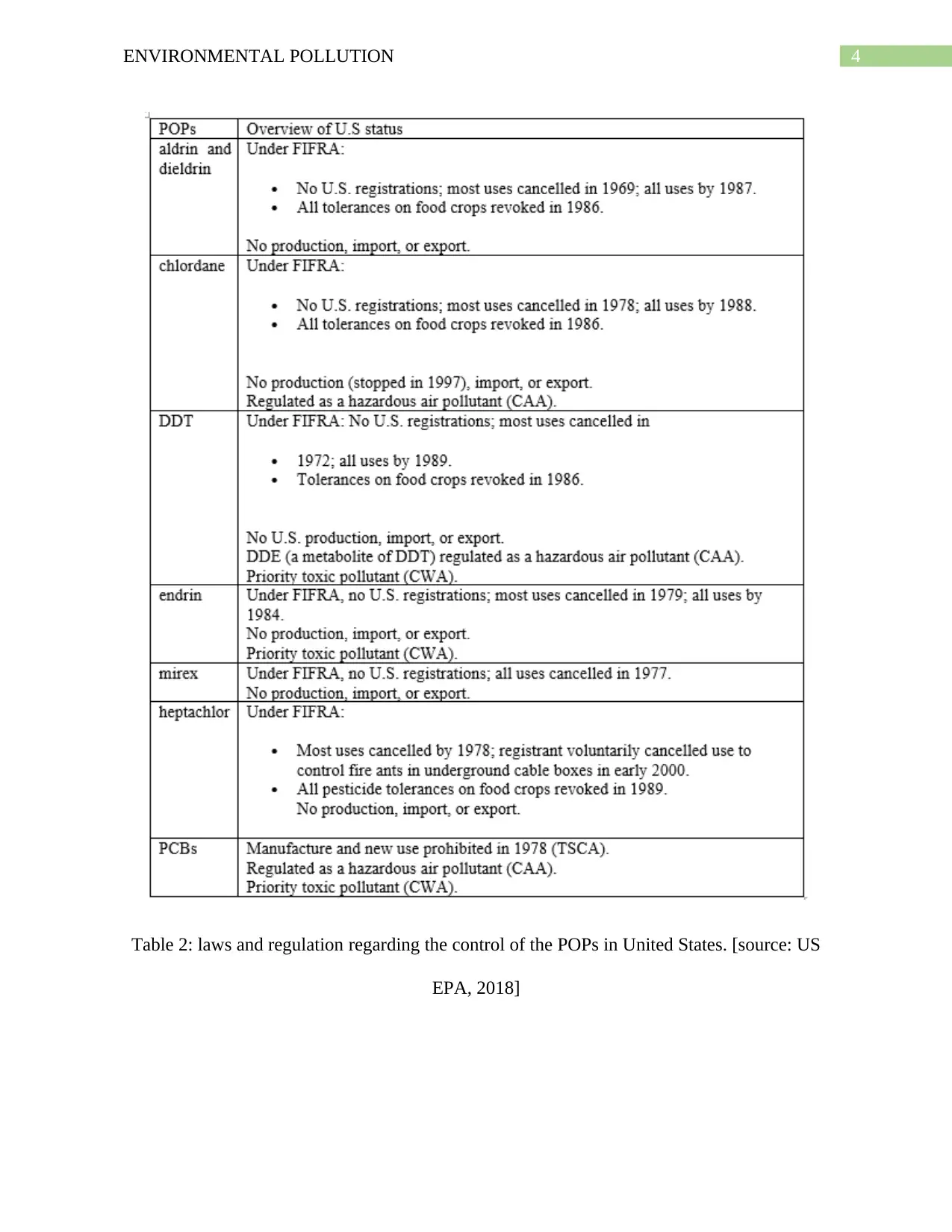
4ENVIRONMENTAL POLLUTION
Table 2: laws and regulation regarding the control of the POPs in United States. [source: US
EPA, 2018]
Table 2: laws and regulation regarding the control of the POPs in United States. [source: US
EPA, 2018]
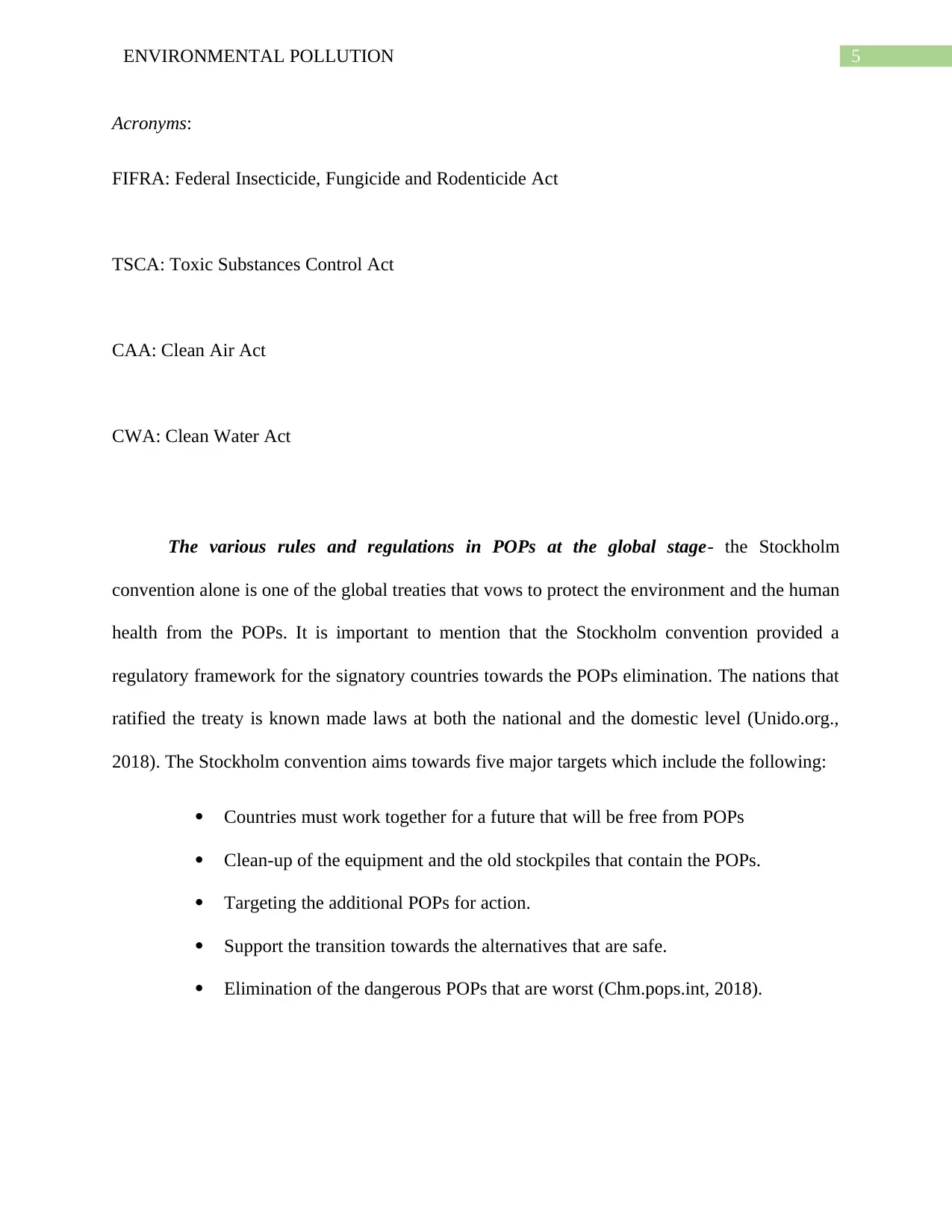
5ENVIRONMENTAL POLLUTION
Acronyms:
FIFRA: Federal Insecticide, Fungicide and Rodenticide Act
TSCA: Toxic Substances Control Act
CAA: Clean Air Act
CWA: Clean Water Act
The various rules and regulations in POPs at the global stage- the Stockholm
convention alone is one of the global treaties that vows to protect the environment and the human
health from the POPs. It is important to mention that the Stockholm convention provided a
regulatory framework for the signatory countries towards the POPs elimination. The nations that
ratified the treaty is known made laws at both the national and the domestic level (Unido.org.,
2018). The Stockholm convention aims towards five major targets which include the following:
Countries must work together for a future that will be free from POPs
Clean-up of the equipment and the old stockpiles that contain the POPs.
Targeting the additional POPs for action.
Support the transition towards the alternatives that are safe.
Elimination of the dangerous POPs that are worst (Chm.pops.int, 2018).
Acronyms:
FIFRA: Federal Insecticide, Fungicide and Rodenticide Act
TSCA: Toxic Substances Control Act
CAA: Clean Air Act
CWA: Clean Water Act
The various rules and regulations in POPs at the global stage- the Stockholm
convention alone is one of the global treaties that vows to protect the environment and the human
health from the POPs. It is important to mention that the Stockholm convention provided a
regulatory framework for the signatory countries towards the POPs elimination. The nations that
ratified the treaty is known made laws at both the national and the domestic level (Unido.org.,
2018). The Stockholm convention aims towards five major targets which include the following:
Countries must work together for a future that will be free from POPs
Clean-up of the equipment and the old stockpiles that contain the POPs.
Targeting the additional POPs for action.
Support the transition towards the alternatives that are safe.
Elimination of the dangerous POPs that are worst (Chm.pops.int, 2018).
⊘ This is a preview!⊘
Do you want full access?
Subscribe today to unlock all pages.

Trusted by 1+ million students worldwide
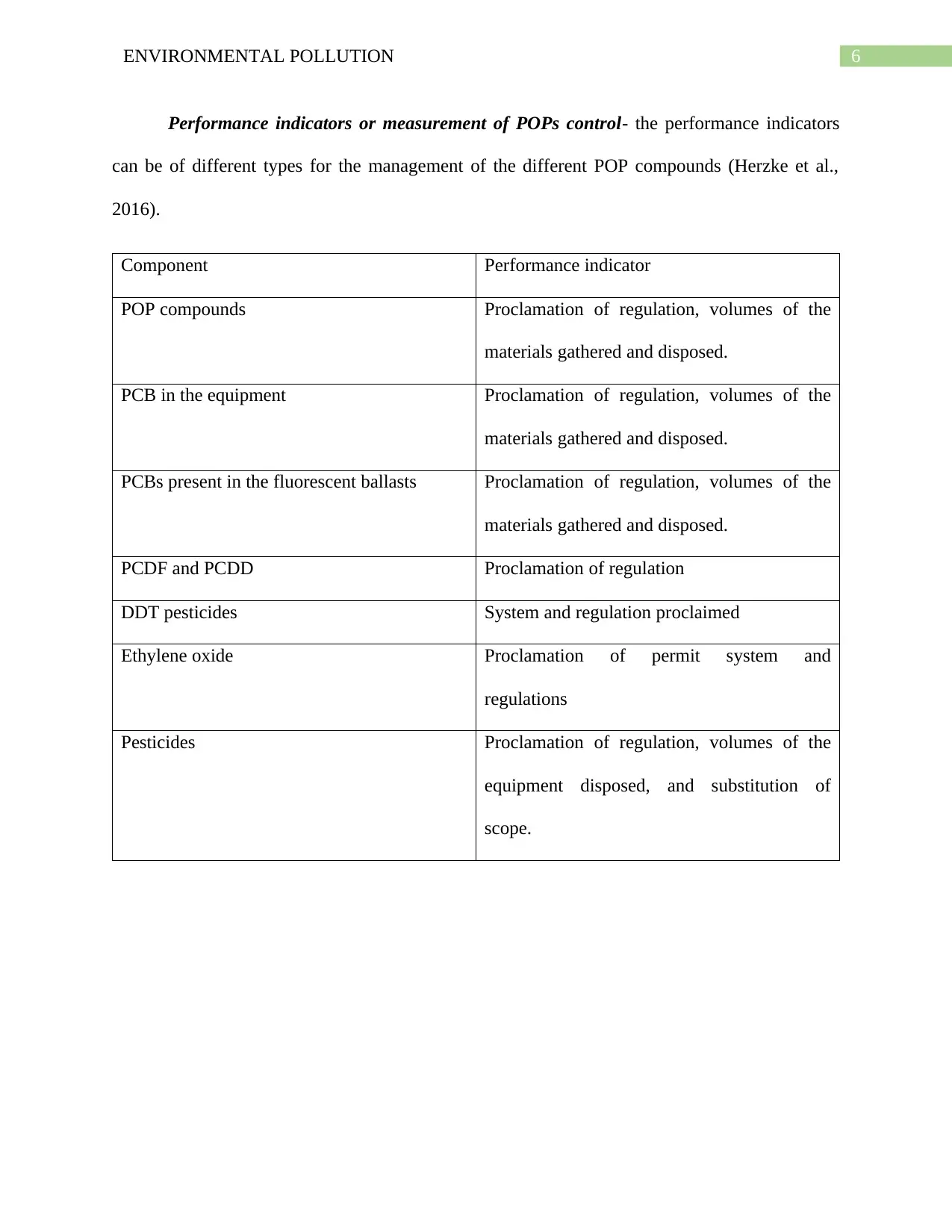
6ENVIRONMENTAL POLLUTION
Performance indicators or measurement of POPs control- the performance indicators
can be of different types for the management of the different POP compounds (Herzke et al.,
2016).
Component Performance indicator
POP compounds Proclamation of regulation, volumes of the
materials gathered and disposed.
PCB in the equipment Proclamation of regulation, volumes of the
materials gathered and disposed.
PCBs present in the fluorescent ballasts Proclamation of regulation, volumes of the
materials gathered and disposed.
PCDF and PCDD Proclamation of regulation
DDT pesticides System and regulation proclaimed
Ethylene oxide Proclamation of permit system and
regulations
Pesticides Proclamation of regulation, volumes of the
equipment disposed, and substitution of
scope.
Performance indicators or measurement of POPs control- the performance indicators
can be of different types for the management of the different POP compounds (Herzke et al.,
2016).
Component Performance indicator
POP compounds Proclamation of regulation, volumes of the
materials gathered and disposed.
PCB in the equipment Proclamation of regulation, volumes of the
materials gathered and disposed.
PCBs present in the fluorescent ballasts Proclamation of regulation, volumes of the
materials gathered and disposed.
PCDF and PCDD Proclamation of regulation
DDT pesticides System and regulation proclaimed
Ethylene oxide Proclamation of permit system and
regulations
Pesticides Proclamation of regulation, volumes of the
equipment disposed, and substitution of
scope.
Paraphrase This Document
Need a fresh take? Get an instant paraphrase of this document with our AI Paraphraser
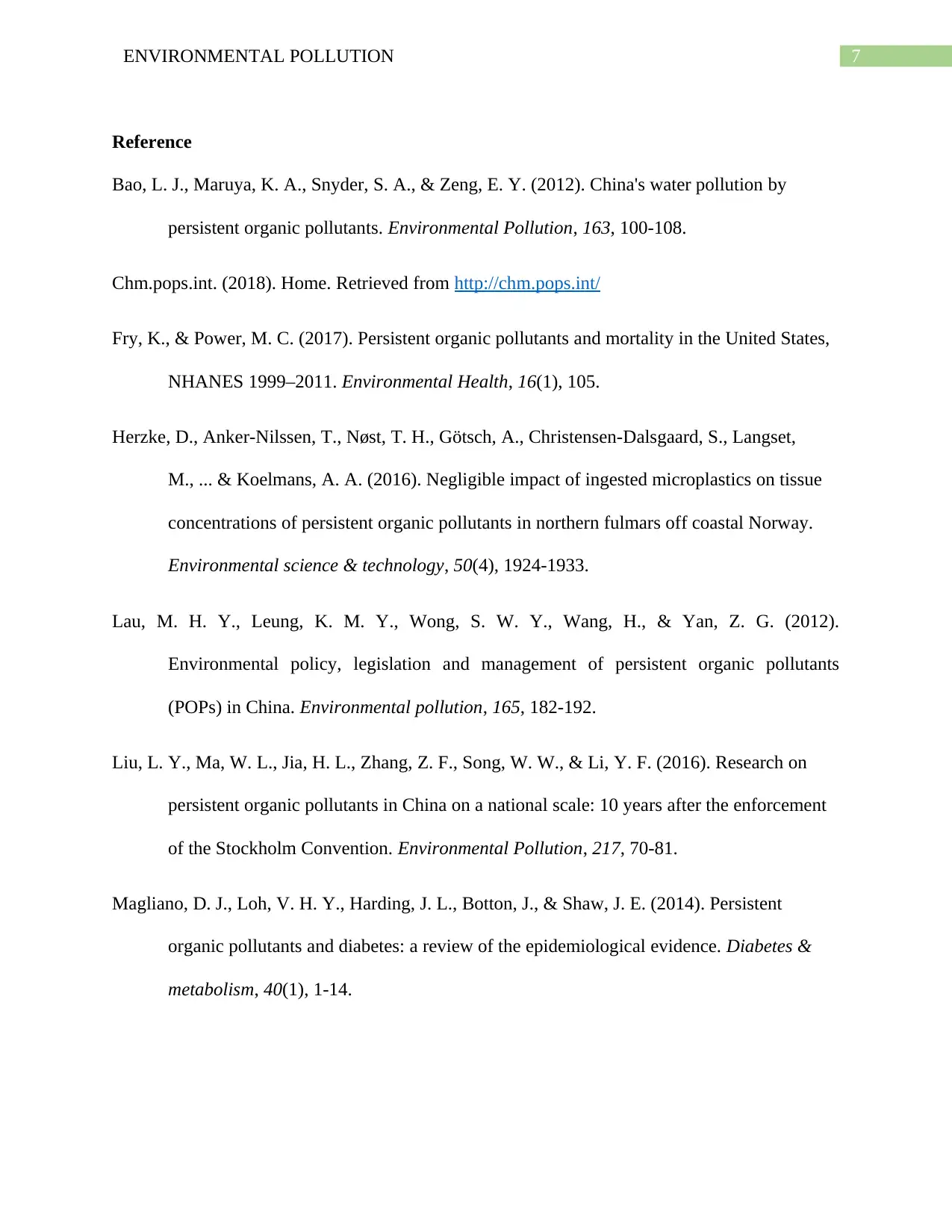
7ENVIRONMENTAL POLLUTION
Reference
Bao, L. J., Maruya, K. A., Snyder, S. A., & Zeng, E. Y. (2012). China's water pollution by
persistent organic pollutants. Environmental Pollution, 163, 100-108.
Chm.pops.int. (2018). Home. Retrieved from http://chm.pops.int/
Fry, K., & Power, M. C. (2017). Persistent organic pollutants and mortality in the United States,
NHANES 1999–2011. Environmental Health, 16(1), 105.
Herzke, D., Anker-Nilssen, T., Nøst, T. H., Götsch, A., Christensen-Dalsgaard, S., Langset,
M., ... & Koelmans, A. A. (2016). Negligible impact of ingested microplastics on tissue
concentrations of persistent organic pollutants in northern fulmars off coastal Norway.
Environmental science & technology, 50(4), 1924-1933.
Lau, M. H. Y., Leung, K. M. Y., Wong, S. W. Y., Wang, H., & Yan, Z. G. (2012).
Environmental policy, legislation and management of persistent organic pollutants
(POPs) in China. Environmental pollution, 165, 182-192.
Liu, L. Y., Ma, W. L., Jia, H. L., Zhang, Z. F., Song, W. W., & Li, Y. F. (2016). Research on
persistent organic pollutants in China on a national scale: 10 years after the enforcement
of the Stockholm Convention. Environmental Pollution, 217, 70-81.
Magliano, D. J., Loh, V. H. Y., Harding, J. L., Botton, J., & Shaw, J. E. (2014). Persistent
organic pollutants and diabetes: a review of the epidemiological evidence. Diabetes &
metabolism, 40(1), 1-14.
Reference
Bao, L. J., Maruya, K. A., Snyder, S. A., & Zeng, E. Y. (2012). China's water pollution by
persistent organic pollutants. Environmental Pollution, 163, 100-108.
Chm.pops.int. (2018). Home. Retrieved from http://chm.pops.int/
Fry, K., & Power, M. C. (2017). Persistent organic pollutants and mortality in the United States,
NHANES 1999–2011. Environmental Health, 16(1), 105.
Herzke, D., Anker-Nilssen, T., Nøst, T. H., Götsch, A., Christensen-Dalsgaard, S., Langset,
M., ... & Koelmans, A. A. (2016). Negligible impact of ingested microplastics on tissue
concentrations of persistent organic pollutants in northern fulmars off coastal Norway.
Environmental science & technology, 50(4), 1924-1933.
Lau, M. H. Y., Leung, K. M. Y., Wong, S. W. Y., Wang, H., & Yan, Z. G. (2012).
Environmental policy, legislation and management of persistent organic pollutants
(POPs) in China. Environmental pollution, 165, 182-192.
Liu, L. Y., Ma, W. L., Jia, H. L., Zhang, Z. F., Song, W. W., & Li, Y. F. (2016). Research on
persistent organic pollutants in China on a national scale: 10 years after the enforcement
of the Stockholm Convention. Environmental Pollution, 217, 70-81.
Magliano, D. J., Loh, V. H. Y., Harding, J. L., Botton, J., & Shaw, J. E. (2014). Persistent
organic pollutants and diabetes: a review of the epidemiological evidence. Diabetes &
metabolism, 40(1), 1-14.
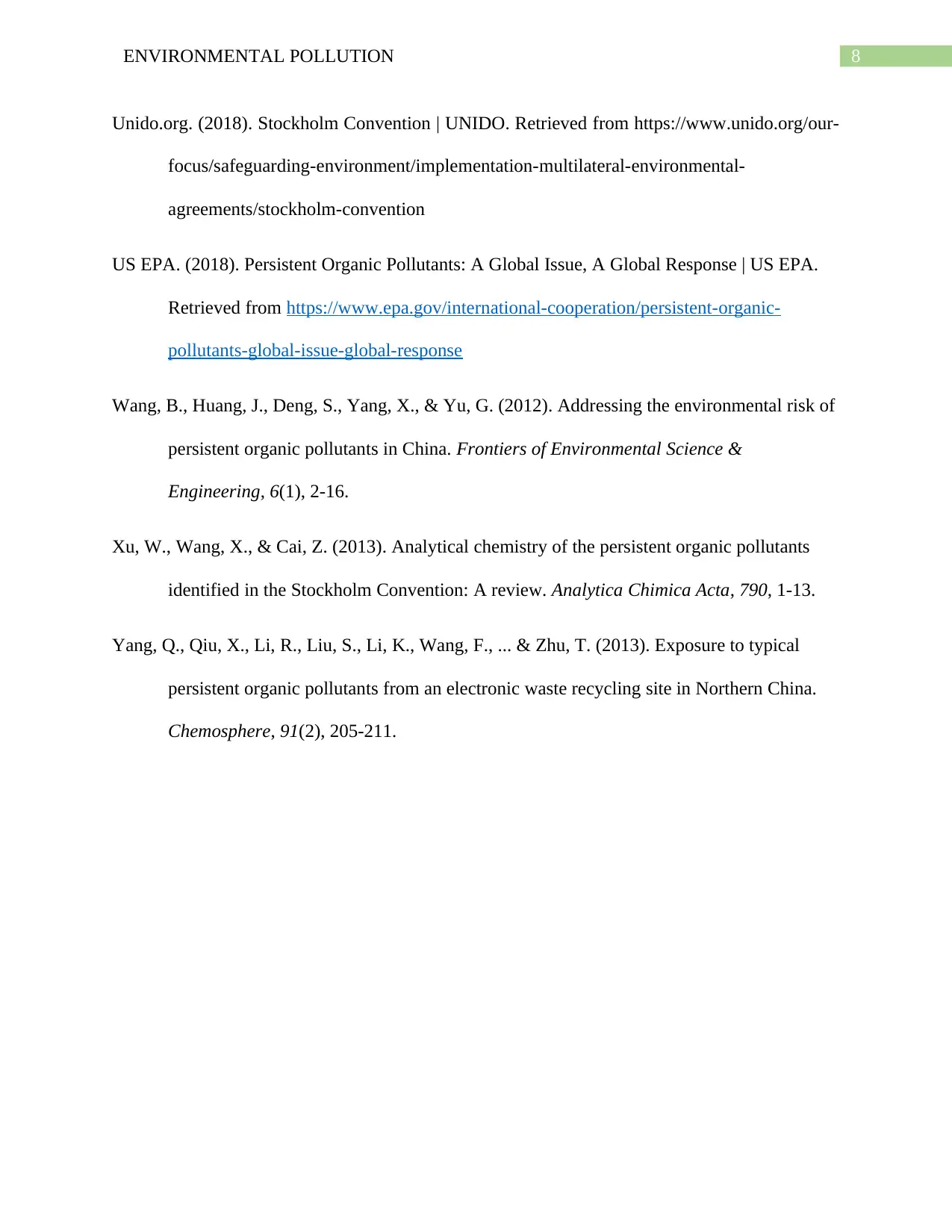
8ENVIRONMENTAL POLLUTION
Unido.org. (2018). Stockholm Convention | UNIDO. Retrieved from https://www.unido.org/our-
focus/safeguarding-environment/implementation-multilateral-environmental-
agreements/stockholm-convention
US EPA. (2018). Persistent Organic Pollutants: A Global Issue, A Global Response | US EPA.
Retrieved from https://www.epa.gov/international-cooperation/persistent-organic-
pollutants-global-issue-global-response
Wang, B., Huang, J., Deng, S., Yang, X., & Yu, G. (2012). Addressing the environmental risk of
persistent organic pollutants in China. Frontiers of Environmental Science &
Engineering, 6(1), 2-16.
Xu, W., Wang, X., & Cai, Z. (2013). Analytical chemistry of the persistent organic pollutants
identified in the Stockholm Convention: A review. Analytica Chimica Acta, 790, 1-13.
Yang, Q., Qiu, X., Li, R., Liu, S., Li, K., Wang, F., ... & Zhu, T. (2013). Exposure to typical
persistent organic pollutants from an electronic waste recycling site in Northern China.
Chemosphere, 91(2), 205-211.
Unido.org. (2018). Stockholm Convention | UNIDO. Retrieved from https://www.unido.org/our-
focus/safeguarding-environment/implementation-multilateral-environmental-
agreements/stockholm-convention
US EPA. (2018). Persistent Organic Pollutants: A Global Issue, A Global Response | US EPA.
Retrieved from https://www.epa.gov/international-cooperation/persistent-organic-
pollutants-global-issue-global-response
Wang, B., Huang, J., Deng, S., Yang, X., & Yu, G. (2012). Addressing the environmental risk of
persistent organic pollutants in China. Frontiers of Environmental Science &
Engineering, 6(1), 2-16.
Xu, W., Wang, X., & Cai, Z. (2013). Analytical chemistry of the persistent organic pollutants
identified in the Stockholm Convention: A review. Analytica Chimica Acta, 790, 1-13.
Yang, Q., Qiu, X., Li, R., Liu, S., Li, K., Wang, F., ... & Zhu, T. (2013). Exposure to typical
persistent organic pollutants from an electronic waste recycling site in Northern China.
Chemosphere, 91(2), 205-211.
⊘ This is a preview!⊘
Do you want full access?
Subscribe today to unlock all pages.

Trusted by 1+ million students worldwide
1 out of 9
Related Documents
Your All-in-One AI-Powered Toolkit for Academic Success.
+13062052269
info@desklib.com
Available 24*7 on WhatsApp / Email
![[object Object]](/_next/static/media/star-bottom.7253800d.svg)
Unlock your academic potential
Copyright © 2020–2025 A2Z Services. All Rights Reserved. Developed and managed by ZUCOL.




